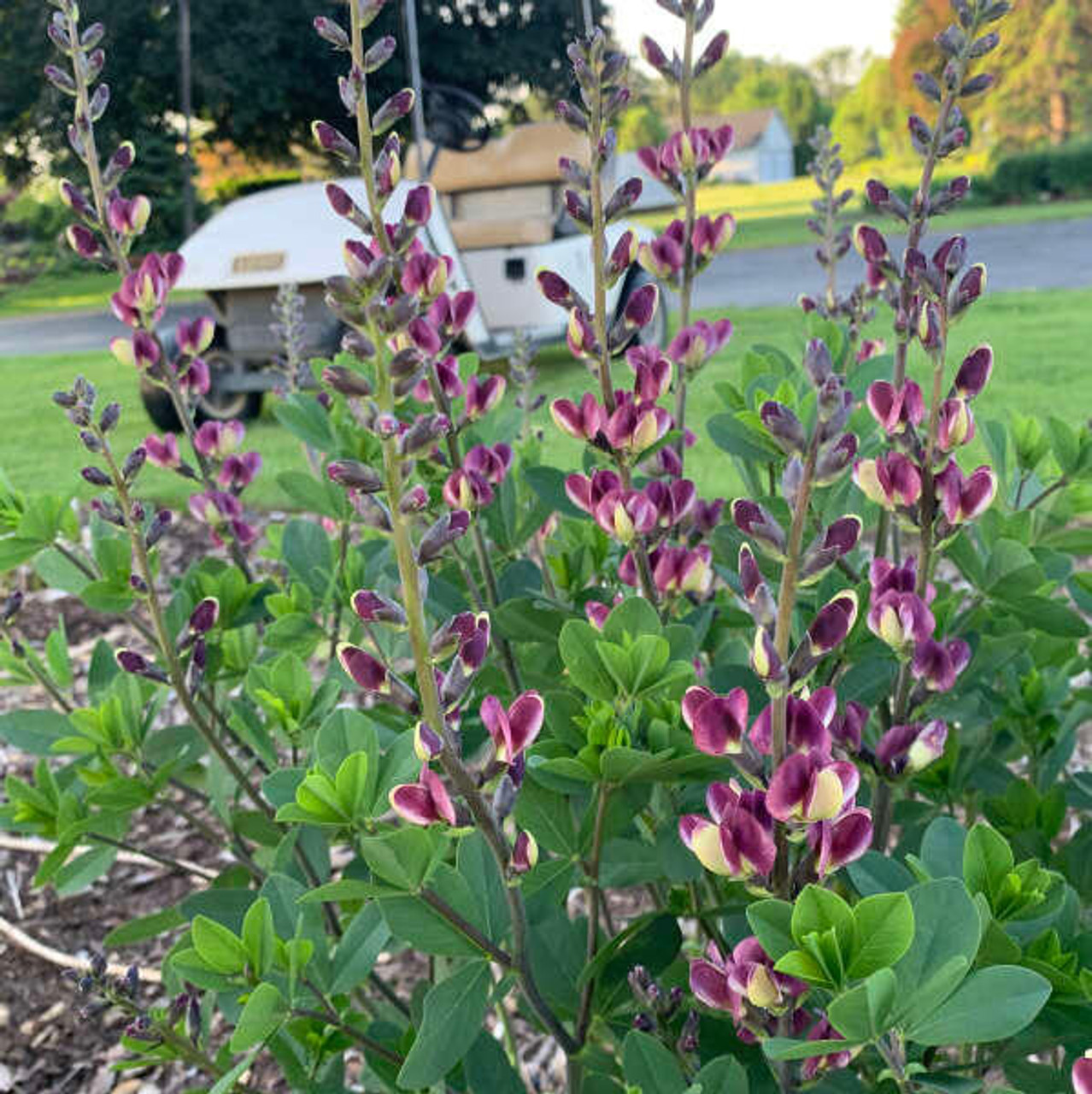Product Description
Baptisia 'Grape Escape' PPAF (25) Bare Root Plants
Common Name: False Indigo
An elegant Baptisia with long dusky purple flower spikes. Showy cream keels accent each individual flower. 'Grape Escape' takes the place of 'Grape Taffy' in our catalog, being taller, more floriferous, and having deeper red-purple tones to the flowers.
Baptisia is easy to grow and will thrive with little maintenance. There are many potential applications in the landscape including meadow plantings, as a backdrop in borders, or as a specimen.
Height: 42.0-48.0 Inches
Spread: 32.0-38.0 Inches
Hardiness Zones: 4,5,6,7,8,9
Flower Color: Purple shades
Foliage Color: Green shades
Full Sun (> 6 hrs. Direct Sun) to Part Shade (4-6 hrs. Direct Sun)
Low to Average Water Needs
Poor to Average Soil Quality
Bloomtime: Late Spring
Attracts Butterflies
Bee Friendly
Deer Resistant
Seasonal Interest: Dried Seed Heads
Growth Rate: Slow
Border Plant, Cut Flower, Cut Foliage, Dried Flower, Salt Tolerant, Specimen, Focal Point
Baptisia 'Grape Escape' is a stunning perennial that brings vibrant color and structural interest to the garden. Here is a breakdown of what makes it so special:
What Makes Baptisia 'Grape Escape' Special
- Unique Flower Color: It boasts long, dusky purple flower spikes with creamy yellow keels, creating a captivating two-toned effect. This color combination is quite unique among Baptisias.
- Abundant Blooms: 'Grape Escape' is known for its profuse flowering, putting on a spectacular show in late spring to early summer.
- Attractive Foliage: The blue-green leaves provide a lovely backdrop to the flowers and add interest even after the blooms fade.
- Long-Lived and Low-Maintenance: Once established, it is a tough and reliable perennial that requires minimal care.
- Deer Resistant: It is generally avoided by deer, making it a great choice for gardens with deer pressure.
- Versatile: It can be used in a variety of garden settings, from borders to meadows.
Description and Details
- Common Name: Grape Escape False Indigo
- Botanical Name: Baptisia 'Grape Escape'
- Mature Size: 3-4 feet tall, 2-3 feet wide
- Foliage: Blue-green, trifoliate leaves
- Flowers: Dusky purple with creamy yellow keels, blooming in late spring to early summer
- Growth Habit: Upright, vase-shaped
- Hardiness Zones: 4-9
- Light: Full sun to light shade
- Soil: Well-drained, adaptable to various soil types
- Water: Drought-tolerant once established
Landscaping Design Tips
- Back of the Border: Its height makes it ideal for the back of borders, where it can provide a backdrop for shorter plants.
- Specimen Plant: It can also be used as a specimen plant to draw attention to its unique flowers and form.
- Meadow Gardens: It is a natural choice for meadow gardens, where it can mingle with other wildflowers and grasses.
- Cottage Gardens: Its vibrant color and upright form make it a good fit for cottage gardens.
- Cut Flower Gardens: The long flower spikes are excellent for cutting and arranging.
- Companion Plants: Consider pairing it with other sun-loving perennials with contrasting colors and textures, such as:
- Coneflowers (Echinacea)
- Yarrow (Achillea)
- Salvia
- Ornamental grasses
Planting and Care
- Planting:
- Choose a sunny location with well-drained soil.
- Plant in spring or fall.
- Space plants according to their mature size (about 2-3 feet apart).
- Water thoroughly after planting.
- Care:
- Water regularly until established, then only during prolonged dry spells.
- Fertilize lightly in spring if desired.
- Deadhead spent flowers to encourage reblooming (though not essential).
- Cut back stems in late fall or early spring.
- Avoid disturbing established clumps, as they can be slow to recover.
Additional Notes
- 'Grape Escape' is a relatively new Baptisia variety that is gaining popularity for its unique flower color and abundant blooms.
- It is a great choice for gardeners looking for a low-maintenance, deer-resistant perennial with long-lasting color.
- The seed pods that follow the flowers are also ornamental, adding interest to the garden in late summer and fall.
Other Details
The most important part of the plant is its root system. Healthy roots are the foundation of a healthy, vibrant plant. The type of plug container used is based on the specific needs of the plants. Perennials offered as bare root traditionally perform better when planted as bare root.Planted in a specialized mix, potted plants have well established root systems. Top growth stage will vary depending on the current life cycle and time of year when shipped. In Winter and early Spring dormant plants may be shipped. Dormant plants may be planted right away, even before the last frost date.
Most bare root varieties are field grown for at least one season, though Hemerocallis and Hosta are grown for two seasons. The bulk of the soil is removed during the harvesting process and the tops of most varieties are trimmed back to the crown. They are graded, packed in shredded aspen or sphagnum moss and stored in freezers until ready to be shipped.
See our Container Sizes and Bare Root Perennials pages for more information.
Plant information and care is provided in the Overview section, Plant Genus Page and general information is provided in the Planting Care & Guides. Additional questions can be asked on each Plant page.
Plant Spacing: Using the maximum mature spread or width of a plant to guide spacing, ensures space to grow to full size. To fill an area sooner, plant them closer together. Just remember, future thinning or transplanting may be needed.
Water: Keep a close eye on newly planted perennials, especially throughout the first growing year. Most early plant loss is due to too much or too little water!





